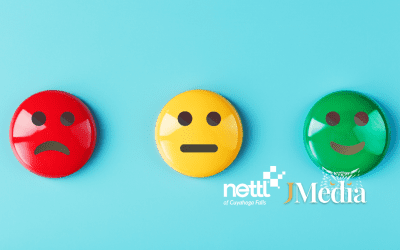You’d be forgiven for thinking that selling online is a completely different kettle of fish. The truth is, although it may be a different type of kettle, the fish have very similar tendencies.
Our attention span may be shorter today. And there is an incredible amount of competition for our limited attention. But although the advertising medium has changed, the psychology remains the same. Humans don’t evolve as quickly as iPhones it seems.
Our Nettl journal features a series of posts exploring selling online. They demonstrate the notion that e-commerce still shares a lot of practices and philosophies with the good old fashioned brick and mortar commerce we’re all familiar with. Previously, we’ve discussed:
#1: Merchandising your online store
A guide that explains the similarities between a good, classic retail display and showcasing your products online. Containing examples of online merchandising done well, top tips for photography and descriptions, advice on reviews, and more.
#2: Building credibility and establishing trust online
There are lots of indicators in the real world that help signal trust and credibility to a customer. This article explains what we can do to send out the same reassuring signals online.
#3: Focusing on user experience to increase customers and conversions
User experience is of key importance, whether here in the real world around us or online. We discuss 5 website specific UI/UX tips to help you get some quick wins on the board that will help improve your customers’ user experience.
#4: Attracting customers
A beautiful, well-stocked shop means very little if there isn’t the footfall passing through it.
And even then, a store needs enticing reasons to bring people off the street, through the doors and buying up its goods.
A website is no different.
However, rather than targeting passers by on the street, we’re looking for destination shoppers when we sell online.
A destination shopper is a customer that thinks of your store first when they need to buy something. This means they give you their support and sales consistently – it’s what we should aim to do as a business.
Driving these kinds of customers to your site will fall into two broad categories: online and offline marketing.
Just like the high street shops and out of town superstores, your promotional efforts should include a mix of many different activities – both online and offline strategies – if you want to get the most ‘bang for your buck’. This kind of multi-channel approach has been proven to work, time and time again. Even giant superstores like Tesco choose to mix up their marketing activity in order to maximize their overall return on investment.
But you don’t need a supermarket budget to have a successful marketing campaign. You just need a keen eye on who your customer really is, and a little dose of creativity.
Now, let’s look at some ways you can start promoting…
#1 Optimise (SEO)
Everybody wants to be number one on Google. Being in the number one spot increases the likelihood of traffic to our site and in turn increases the likelihood of sales and enquiries. However, the reality of achieving this is far from simple. It requires a large ongoing budget and significant resource and sometimes that’s only just to get on the first page.
Nonetheless, laying the foundations for a search engine friendly site should be your starting point if you’re serious about the future rankings of your website.
Though Search Engine Optimization (SEO) is a complex and ever changing concept, to boil it down to its basics: it’s all about relevance and authority.
Relevance, or ‘on-page SEO’ as its known, is about whether search engines can find information on your site that is relevant to the user’s search term.
So, for example, if someone were to search looking for ‘plumbers near me’, your page about artisanal cupcakes is never going to be relevant to their search query and so Google isn’t going to show someone your page. If your page is made to be relevant for plumbing in the local area, however, then you’ve got a far better chance of being shown to a user. This is because a search engine thinks that you might be useful in answering or providing information about a user’s search query.
Authority is the other key aspect of SEO. It’s what’s known as ‘off-page SEO’ and refers to how much search engines trust your website which then helps to determine where they decide your website will rank.
An easy to understand element of what makes up the authority of a site would be its age, for example. If a domain has been around for years and years with a great track record then it’s probably going to rank higher than a site that only popped up a couple of hours ago. It’s all about appearing trust worthy to a search engine.
The rules for both on-page and off-page SEO are varied and complex. They change regularly according to the search engine and its algorithms so it can be confusing to anyone starting out on their optimizing journey.
For those brave enough to leap in, here are some easy initial ways you can start optimizing:
- Optimize your site’s content in a structured way.
- Help search engines identify the relevance of your pages.
- Identify keywords based on search volume.
- Balance keyword targeting with usability and user experience.
We have an abundant array of free SEO webinars to help you grasp everything you need to know to get started.
Or you can, of course, talk to us about how you can make your site more relevant too. We’re your friendly, local SEO experts and we’re here to make SEO transparent, simple and accessible to all our clients.
You can get a free audit from us to understand how you could begin to improve your online presence. Or go ahead and take a look through our different SEO packages to see what could best work for you.
#2 Content marketing
Another tried and tested hotspot for attracting new visitors to your site is content marketing. Like peas in a pod, content marketing and SEO are best friends. But you don’t need to be an SEO empresario to get started. Simply create content that your audience will find useful and go from there. Think videos, podcasts, articles, whitepapers, surveys, guides, graphics, blogs or just latest news sections.
Google likes fresh, new, relevant content, but so do real people! Let’s take a simple blog for example. Sure, a lively blog will help your search engine rankings but it will also indicate that you’re open, active and on top of your game.
Think of a blog as an open virtual door, it lets customers know that you’re open, active and ready to engage with them. Once they’re inside, good quality blog content can help them review you as a trusted and valuable resource which means they’ll be more likely to buy from you and keep coming back.
This only works, however, when your blog posts have something called ‘a call-to-action’. A call-to-action is something like encouraging them to download a guide, encouraging them to book a demo, or directing them to a product page. It’s these that will help turn blog readers into leads.
Other tips to keep a customers engaged with your blog:
- Keep blog posts going out at consistent, regular intervals, so visitors can know when to expect new content.
- To quote Master Yoda, ‘do or do not – there is no try’. A blog feature on your website with no news in the last 6 months looks terrible and could actually be detrimental to your business compared to no blog at all.
- Remember to give before asking to receive. It’s ok to use a blog post to promote your products and services but don’t always be selling. Provide plenty of valuable, useful content, for free, and the leads will generate themselves.
If you are interested in learning more about content marketing, head over to our awesome free webinar about creating compelling content.
Too busy? Speak to us about our monthly concierge services that can publish fresh regular ongoing content, and keep everything up to date.
#3 Paid search / PPC
Those adverts you see at the top of Google search results are paid-for adverts. They are a great and effective way of driving traffic to your website instantly but, unsurprisingly, they do come at a cost.
It works by allowing companies to bid on a ad placement for a specific keyword related to their business. They will then appear as an ad and get charged for any clicks on their ad.
For example, if a business were to get a bid on ‘PPC software’ at £3 per click then they would have to pay £3 every time a user clicks on one of their PPC software ads. This might sound like a costly strategy but if each click generated an average of £100 in sales, they’d be getting a hefty return on investment.
Increasingly, Google Ads (other search engines obviously available) has been used to push traffic to transactional websites and local searches. It’s an effective way to drive sales quickly as ads can be up and running relatively quickly and only focus on specified keywords that your customers are currently looking for online. They’re also easily measured and tracked so you can understand your return on investment a lot better than with some other marketing channels.
As a Google Partner, we are an approved agency that can help tailor and manage these PPC advertising campaigns for you.
We can advise you on budget, content and the best possible approach to ensure that your business gets found by customers when they search online.
As mentioned earlier, with pay-per-click advertising, you only pay when someone clicks on your advert and visits your website. How much you budget is up to you.
Regardless of how much you decide to invest, we would advise the following things when embarking on a PPC campaign:
- Research the market’s keyword demand to learn which to target.
- Use long-tail keywords as though they may produce less traffic, they can convert better.
- Use negative keywords and keyword modifiers for efficient targeting.
- Track your campaign performance daily and adjust accordingly.
Check out our range of paid search packages or book in a for a free consultation with Nettl today to learn more.
#4 Email marketing
An effective way to re-market to your customers is via email marketing. Sending the right message, to the right person, at the right time, in the right places can work real marketing magic.
Email marketing helps you connect with your client base, promote your brand, and increase sales. You can do a lot of things with emails, whether it’s selling products, sharing some brand news, or improving your cart abandonment rate.
And it works! For every $1 spent, an email has an average $42 return on investment.
It’s important to send a combination of both general and focused emails if you want to see this kind of return, however, as clients will respond differently to both strategies. The way it looks, what you say and a clear call to action all will impact on a campaigns’ success so it’s important to get it right.
The starting point of any promotion – in any industry – is how well you collect and maintain your client data. Collecting data in the right way is as important as receiving the enquiry itself. This information allows you to re-market to your clients in a targeted way. You’ll see your highest ROI when you build and maintain an engaged subscriber list made up of people who want to receive your messages.
Here at Nettl, we are experts in designing e-shots for maximum impact and then reporting back on their effectiveness. These are our top tips on how to undertake a successful email marketing campaign:
- Offer something of perceived value, like vouchers or ebooks, in exchange for email.
- Ensure that your email marketing is something that is done regularly.
- Use with other forms of online and offline marketing to maximize return.
- Use campaign specific landing pages on your website to test their effectiveness.
Book in a for a free consultation with us today to learn more about how you can maximize your return using email marketing campaigns.
#5 Social media
To win on the web, you have to be there whenever your consumer needs you. You have to listen to the things they like and to react to the things they don’t.
Previously, businesses would have to conduct research in order to get this kind of information, which was both costly and laborious. Now, with the help of social media, business owners can get real and direct customer feedback instantaneously. The benefit here is that not only are you receiving valuable insights from your customers, you are also strengthening your brand credibility and loyalty through positive consumer feedback.
It’s all about the ‘micro-moments’.
Potential customers will need to engage with your business across lots of different channels and devices before taking the next step. You need to be ready to connect with them in whatever medium they want to communicate. Engaging can build lifelong customers.
Not only that but social media marketing provides you with the possibility of reaching a greater target audience. Online campaigns allow you the opportunity to get in front of customers on both a local and global front, at a relatively low cost.
So what are the routes to high level engagement for your business?
Being present on social media channels is the first step. Different platforms can aid in different marketing goals.
Facebook helps you show off the good things you do. Instagram helps you showcase products and services. Twitter helps you listen to your target demographic, answer questions and join relevant conversations. Linkedin is great for networking online.
Which combination you choose to focus on is up to you but regardless of platform, here are three things you should do if you want to boost your online engagement:
- Start building brand advocates with likeable and shareable content.
- Pick up the phone and talk to your clients or engage with them at networking events.
- Regularly write and publish blog articles.
Social media marketing gives you the opportunity to grow awareness using both paid and organic means. For help building a social media identity that engages your audience, check out our social media experts page.
Want to see how social media can work hand in hand with SEO? Check out our free webinar.
#6 Printed marketing
Even with the different online tools available to promote your business, offline printed marketing still offers some of the best return on your investment.
Direct mail shots, handouts and magazine inserts are just some of the ways offline marketing can get in front of your customers. And it helps keep you on their minds too.
A study conducted in Canada proved that consumers could remember brands easier and more effectively after they had been exposed to print marketing. They had two test groups: one group was shown a digital advertisement and the other group were shown a print version.
The results were impressive. The brand recall was 70% higher among those given the print piece compared to digital.
At the end of a client meeting, a networking event or a presentation, you can’t leave your website behind. You need to leave a lasting positive impression using tactile printed collateral such as business cards, leaflets, hand-outs, company brochures and folders.
At Nettl, we offer a varied range of printed products meaning that we have something for everyone. We can help plan, design and print your campaign.
Take a look at our printing playbook for lots of ideas on how to use print to promote your business and drive traffic to your website.
#7 Exhibitions
Just like with print and direct mail, online traffic doesn’t always begin online. One of the best ways to get your website in front of the right group of people is to go where they go.
We all need to be where our customers are. That’s online and offline. It’s at exhibitions and events. It’s selling via e-commerce and persuading, face-to-face.
The best businesses use a combination of print, display and digital marketing to touch customers in different ways.
Expos, exhibitions, trade fairs or trade shows are each an incredibly useful marketing activity, when utilized correctly. They are an excellent way to gain exposure for your brand, generate new leads and build your network.
Perhaps your goal is new customer acquisition. Profile your most profitable customers from your existing customer base to create an avatar of your ideal customer. Book your place at the event that promises to have most of those in attendance.
For example, if your ideal customers are people who are getting married, value a consultative service, forward-planning and have a significant wedding budget, a wedding & honeymoon fair is your best bet.
Engage with your audience and give them a reason to head to you website. Whether that is today, or in the future. Often at the top of the funnel, connections made at shows offer a unique way to keep in touch through subsequent email, social media and direct mail marketing.
Check out our guide: 5 steps to successful exhibition planning for a way to maximize your impact at trade shows, expos and exhibitions.
Attract and engage
Everything we do at Nettl is about helping you to attract attention and engage with your audience.
To move the needle, simply take the next step. Arrange a free appointment with us today.

















0 Comments